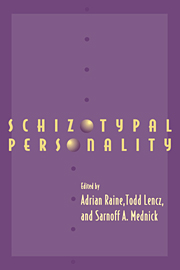Book contents
- Frontmatter
- Contents
- List of contributors
- Preface
- Acknowledgments
- Part I Introduction
- Part II Genetics and neurodevelopment
- Part III Assessment
- Part IV Categorical versus dimensional approaches
- Part V Psychophysiology and psychopharmacology
- 10 Schizotypal personality and skin conductance orienting
- 11 Attention, startle eye-blink modification, and psychosis proneness
- 12 Brain structure/function and the dopamine system in schizotypal personality disorder
- Part VI Neuropsychology
- Part VII Brain imaging
- Part VIII Conclusion
- Part IX Appendix
- Name Index
- Subject Index
11 - Attention, startle eye-blink modification, and psychosis proneness
from Part V - Psychophysiology and psychopharmacology
Published online by Cambridge University Press: 04 August 2010
- Frontmatter
- Contents
- List of contributors
- Preface
- Acknowledgments
- Part I Introduction
- Part II Genetics and neurodevelopment
- Part III Assessment
- Part IV Categorical versus dimensional approaches
- Part V Psychophysiology and psychopharmacology
- 10 Schizotypal personality and skin conductance orienting
- 11 Attention, startle eye-blink modification, and psychosis proneness
- 12 Brain structure/function and the dopamine system in schizotypal personality disorder
- Part VI Neuropsychology
- Part VII Brain imaging
- Part VIII Conclusion
- Part IX Appendix
- Name Index
- Subject Index
Summary
Attentional and information processing dysfunctions have long been considered to be core deficits of schizophrenia (Bleuler, 1911/1950; Kraepelin, 1919). According to this view, many of the characteristic symptoms of schizophrenia are consequences of underlying attentional and information processing dysfunctions. Despite the apparent consensus concerning the importance of these dysfunctions, close examination of the literature reveals considerable disagreement about their specific nature. Some investigators have suggested that schizophrenic patients suffer from primary deficits in controlled attentional processes (e.g., Callaway & Naghdi, 1982; Gjerde, 1983; Nuechterlein & Dawson, 1984b). Others have hypothesized primary deficits in the automatic, preattentive stages of information processing (e.g., Braff & Geyer, 1990; Frith, 1979; Venables, 1984). The possibility that primary deficits in automatic processing might lead to dysfunctions in controlled processing in some situations has also been considered (e.g., Nuechterlein & Dawson, 1984b).
The distinction between automatic and controlled cognitive processes has been prominent in cognitive psychology since the 1970s (Posner & Snyder, 1975; Shiffren & Schneider, 1977). Although there is not perfect agreement about all characteristics that distinguish automatic and controlled processes, there is nevertheless fundamental agreement about the key distinctions (Schneider, Dumais, & Shiffrin, 1984). Automatic cognitive processes occur rapidly, in parallel, demand little or no conscious attention and effort, and are difficult if not impossible to suppress voluntarily. Controlled cognitive processes, in contrast, occur slowly, in series, demand allocation of attentional resources and effort, and are under voluntary control. Most cognitive psychologists agree that automatic and controlled processes may occur in rapid sequence following presentation of salient stimuli.
Keywords
- Type
- Chapter
- Information
- Schizotypal Personality , pp. 250 - 271Publisher: Cambridge University PressPrint publication year: 1995
- 6
- Cited by

